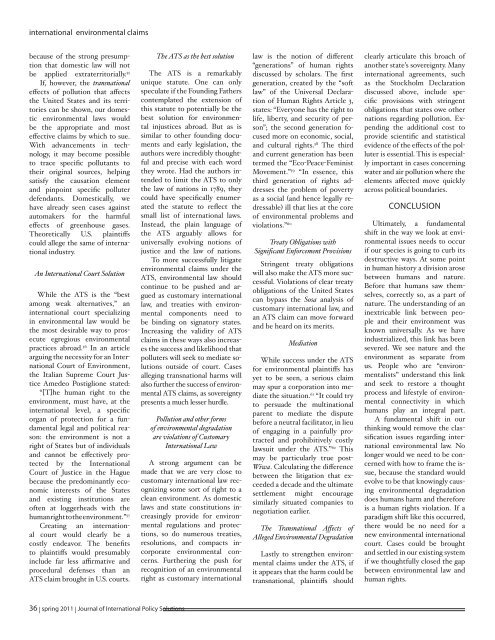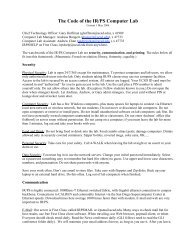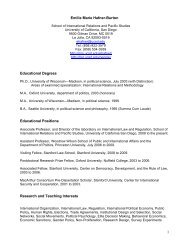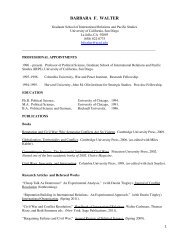to download the full journal. (1.2MB PDF) - School of International ...
to download the full journal. (1.2MB PDF) - School of International ...
to download the full journal. (1.2MB PDF) - School of International ...
You also want an ePaper? Increase the reach of your titles
YUMPU automatically turns print PDFs into web optimized ePapers that Google loves.
international environmental claims<br />
because <strong>of</strong> <strong>the</strong> strong presumption<br />
that domestic law will not<br />
be applied extraterri<strong>to</strong>rially. 55<br />
If, however, <strong>the</strong> transnational<br />
effects <strong>of</strong> pollution that affects<br />
<strong>the</strong> United States and its terri<strong>to</strong>ries<br />
can be shown, our domestic<br />
environmental laws would<br />
be <strong>the</strong> appropriate and most<br />
effective claims by which <strong>to</strong> sue.<br />
With advancements in technology,<br />
it may become possible<br />
<strong>to</strong> trace specific pollutants <strong>to</strong><br />
<strong>the</strong>ir original sources, helping<br />
satisfy <strong>the</strong> causation element<br />
and pinpoint specific polluter<br />
defendants. Domestically, we<br />
have already seen cases against<br />
au<strong>to</strong>makers for <strong>the</strong> harmful<br />
effects <strong>of</strong> greenhouse gases.<br />
Theoretically U.S. plaintiffs<br />
could allege <strong>the</strong> same <strong>of</strong> international<br />
industry.<br />
An <strong>International</strong> Court Solution<br />
While <strong>the</strong> ATS is <strong>the</strong> “best<br />
among weak alternatives,” an<br />
international court specializing<br />
in environmental law would be<br />
<strong>the</strong> most desirable way <strong>to</strong> prosecute<br />
egregious environmental<br />
practices abroad. 56 In an article<br />
arguing <strong>the</strong> necessity for an <strong>International</strong><br />
Court <strong>of</strong> Environment,<br />
<strong>the</strong> Italian Supreme Court Justice<br />
Amedeo Postiglione stated:<br />
“[T]he human right <strong>to</strong> <strong>the</strong><br />
environment, must have, at <strong>the</strong><br />
international level, a specific<br />
organ <strong>of</strong> protection for a fundamental<br />
legal and political reason:<br />
<strong>the</strong> environment is not a<br />
right <strong>of</strong> States but <strong>of</strong> individuals<br />
and cannot be effectively protected<br />
by <strong>the</strong> <strong>International</strong><br />
Court <strong>of</strong> Justice in <strong>the</strong> Hague<br />
because <strong>the</strong> predominantly economic<br />
interests <strong>of</strong> <strong>the</strong> States<br />
and existing institutions are<br />
<strong>of</strong>ten at loggerheads with <strong>the</strong><br />
human right <strong>to</strong> <strong>the</strong> environment.” 57<br />
Creating an international<br />
court would clearly be a<br />
costly endeavor. The benefits<br />
<strong>to</strong> plaintiffs would presumably<br />
include far less affirmative and<br />
procedural defenses than an<br />
ATS claim brought in U.S. courts.<br />
The ATS as <strong>the</strong> best solution<br />
The ATS is a remarkably<br />
unique statute. One can only<br />
speculate if <strong>the</strong> Founding Fa<strong>the</strong>rs<br />
contemplated <strong>the</strong> extension <strong>of</strong><br />
this statute <strong>to</strong> potentially be <strong>the</strong><br />
best solution for environmental<br />
injustices abroad. But as is<br />
similar <strong>to</strong> o<strong>the</strong>r founding documents<br />
and early legislation, <strong>the</strong><br />
authors were incredibly thoughtful<br />
and precise with each word<br />
<strong>the</strong>y wrote. Had <strong>the</strong> authors intended<br />
<strong>to</strong> limit <strong>the</strong> ATS <strong>to</strong> only<br />
<strong>the</strong> law <strong>of</strong> nations in 1789, <strong>the</strong>y<br />
could have specifically enumerated<br />
<strong>the</strong> statute <strong>to</strong> reflect <strong>the</strong><br />
small list <strong>of</strong> international laws.<br />
Instead, <strong>the</strong> plain language <strong>of</strong><br />
<strong>the</strong> ATS arguably allows for<br />
universally evolving notions <strong>of</strong><br />
justice and <strong>the</strong> law <strong>of</strong> nations.<br />
To more success<strong>full</strong>y litigate<br />
environmental claims under <strong>the</strong><br />
ATS, environmental law should<br />
continue <strong>to</strong> be pushed and argued<br />
as cus<strong>to</strong>mary international<br />
law, and treaties with environmental<br />
components need <strong>to</strong><br />
be binding on signa<strong>to</strong>ry states.<br />
Increasing <strong>the</strong> validity <strong>of</strong> ATS<br />
claims in <strong>the</strong>se ways also increases<br />
<strong>the</strong> success and likelihood that<br />
polluters will seek <strong>to</strong> mediate solutions<br />
outside <strong>of</strong> court. Cases<br />
alleging transnational harms will<br />
also fur<strong>the</strong>r <strong>the</strong> success <strong>of</strong> environmental<br />
ATS claims, as sovereignty<br />
presents a much lesser hurdle.<br />
Pollution and o<strong>the</strong>r forms<br />
<strong>of</strong> environmental degradation<br />
are violations <strong>of</strong> Cus<strong>to</strong>mary<br />
<strong>International</strong> Law<br />
A strong argument can be<br />
made that we are very close <strong>to</strong><br />
cus<strong>to</strong>mary international law recognizing<br />
some sort <strong>of</strong> right <strong>to</strong> a<br />
clean environment. As domestic<br />
laws and state constitutions increasingly<br />
provide for environmental<br />
regulations and protections,<br />
so do numerous treaties,<br />
resolutions, and compacts incorporate<br />
environmental concerns.<br />
Fur<strong>the</strong>ring <strong>the</strong> push for<br />
recognition <strong>of</strong> an environmental<br />
right as cus<strong>to</strong>mary international<br />
law is <strong>the</strong> notion <strong>of</strong> different<br />
“generations” <strong>of</strong> human rights<br />
discussed by scholars. The first<br />
generation, created by <strong>the</strong> “s<strong>of</strong>t<br />
law” <strong>of</strong> <strong>the</strong> Universal Declaration<br />
<strong>of</strong> Human Rights Article 3,<br />
states: “Everyone has <strong>the</strong> right <strong>to</strong><br />
life, liberty, and security <strong>of</strong> person”;<br />
<strong>the</strong> second generation focused<br />
more on economic, social,<br />
and cultural rights. 58 The third<br />
and current generation has been<br />
termed <strong>the</strong> “Eco-Peace-Feminist<br />
Movement.” 59 “In essence, this<br />
third generation <strong>of</strong> rights addresses<br />
<strong>the</strong> problem <strong>of</strong> poverty<br />
as a social (and hence legally redressable)<br />
ill that lies at <strong>the</strong> core<br />
<strong>of</strong> environmental problems and<br />
violations.” 60<br />
Treaty Obligations with<br />
Significant Enforcement Provisions<br />
Stringent treaty obligations<br />
will also make <strong>the</strong> ATS more successful.<br />
Violations <strong>of</strong> clear treaty<br />
obligations <strong>of</strong> <strong>the</strong> United States<br />
can bypass <strong>the</strong> Sosa analysis <strong>of</strong><br />
cus<strong>to</strong>mary international law, and<br />
an ATS claim can move forward<br />
and be heard on its merits.<br />
Mediation<br />
While success under <strong>the</strong> ATS<br />
for environmental plaintiffs has<br />
yet <strong>to</strong> be seen, a serious claim<br />
may spur a corporation in<strong>to</strong> mediate<br />
<strong>the</strong> situation. 61 “It could try<br />
<strong>to</strong> persuade <strong>the</strong> multinational<br />
parent <strong>to</strong> mediate <strong>the</strong> dispute<br />
before a neutral facilita<strong>to</strong>r, in lieu<br />
<strong>of</strong> engaging in a pain<strong>full</strong>y protracted<br />
and prohibitively costly<br />
lawsuit under <strong>the</strong> ATS.” 62 This<br />
may be particularly true post-<br />
Wiwa. Calculating <strong>the</strong> difference<br />
between <strong>the</strong> litigation that exceeded<br />
a decade and <strong>the</strong> ultimate<br />
settlement might encourage<br />
similarly situated companies <strong>to</strong><br />
negotiation earlier.<br />
The Transnational Affects <strong>of</strong><br />
Alleged Environmental Degradation<br />
Lastly <strong>to</strong> streng<strong>the</strong>n environmental<br />
claims under <strong>the</strong> ATS, if<br />
it appears that <strong>the</strong> harm could be<br />
transnational, plaintiffs should<br />
clearly articulate this broach <strong>of</strong><br />
ano<strong>the</strong>r state’s sovereignty. Many<br />
international agreements, such<br />
as <strong>the</strong> S<strong>to</strong>ckholm Declaration<br />
discussed above, include specific<br />
provisions with stringent<br />
obligations that states owe o<strong>the</strong>r<br />
nations regarding pollution. Expending<br />
<strong>the</strong> additional cost <strong>to</strong><br />
provide scientific and statistical<br />
evidence <strong>of</strong> <strong>the</strong> effects <strong>of</strong> <strong>the</strong> polluter<br />
is essential. This is especially<br />
important in cases concerning<br />
water and air pollution where <strong>the</strong><br />
elements affected move quickly<br />
across political boundaries.<br />
CONCLUSION<br />
Ultimately, a fundamental<br />
shift in <strong>the</strong> way we look at environmental<br />
issues needs <strong>to</strong> occur<br />
if our species is going <strong>to</strong> curb its<br />
destructive ways. At some point<br />
in human his<strong>to</strong>ry a division arose<br />
between humans and nature.<br />
Before that humans saw <strong>the</strong>mselves,<br />
correctly so, as a part <strong>of</strong><br />
nature. The understanding <strong>of</strong> an<br />
inextricable link between people<br />
and <strong>the</strong>ir environment was<br />
known universally. As we have<br />
industrialized, this link has been<br />
severed. We see nature and <strong>the</strong><br />
environment as separate from<br />
us. People who are “environmentalists”<br />
understand this link<br />
and seek <strong>to</strong> res<strong>to</strong>re a thought<br />
process and lifestyle <strong>of</strong> environmental<br />
connectivity in which<br />
humans play an integral part.<br />
A fundamental shift in our<br />
thinking would remove <strong>the</strong> classification<br />
issues regarding international<br />
environmental law. No<br />
longer would we need <strong>to</strong> be concerned<br />
with how <strong>to</strong> frame <strong>the</strong> issue,<br />
because <strong>the</strong> standard would<br />
evolve <strong>to</strong> be that knowingly causing<br />
environmental degradation<br />
does humans harm and <strong>the</strong>refore<br />
is a human rights violation. If a<br />
paradigm shift like this occurred,<br />
<strong>the</strong>re would be no need for a<br />
new environmental international<br />
court. Cases could be brought<br />
and settled in our existing system<br />
if we thought<strong>full</strong>y closed <strong>the</strong> gap<br />
between environmental law and<br />
human rights.<br />
36 | spring 2011 | Journal <strong>of</strong> <strong>International</strong> Policy Solutions






